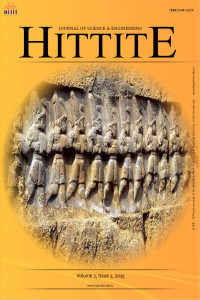Abstract
References
- 1. Boeck LD, Verbeke S, Audenaert A, Mesmaeker LD. Improving the energy performance of residential buildings: A literature review. Renewable and Sustainable Energy Reviews. 52 (2015) 960-975.
- 2. Kaynaklı Ö, Yamankaradeniz R. Isıtma Süreci ve Optimum Yalıtım Kalınlığı Hesabı. VIII. Ulusal Tesisat Mühendisliği Kongresi, İzmir, pp. 187-195, 2007.
- 3. Gelegenis J, Axaopoulos I, Axaopoulos P. Optimum insulation thickness for external walls on different orientations considering the speed and direction of the wind. Applied Energy 117 ( 2014) 167–175.
- 4. Özkan DB, Onan C, Erdem S. Effect of Insulation Materıal Thıckness on Thermal Insulation. Journal of Engineering and Natural Sciences 27 (2009) 190-196.
- 5. Dombaycı ÖA. The environmental impact of optimum insulation thickness for external walls of buildings. Building and Environment 42 (11) (2007) 3855-3859.
- 6. Uçar A, Balo F. Determination of the energy savings and the optimum insulation thickness in the four different insulated exterior walls. Renewable Energy 35 (1) (2010) 88-94.
- 7. Bolattürk A. Determination of optimum insulation thickness for building walls with respect to various fuels and climate zones in Turkey. Applied Thermal Engineering 26(11-12) (2006) 1301-1309.
- 8. Dombaycı ÖA, Gölcü M, Pancar Y. Optimization of insulation thickness for external walls using different energy-sources. Applied Energy 83(9) (2006) 921-928.
- 9. Byun SJ , Park HS, Yi SJ, Song CH , Choi YD , Lee SH, Shin JK. Study on the optimal heat supply control algorithm for district heating distribution network in response to outdoor air temperature. Energy 86 (2015) 247-256.
- 10. Lü X. Modelling of heat and moisture transfer in buildings: I. Model program. Energy and Buildings 34(10) (2002) 1033- 1043.
- 11. Ogonowski S. Modeling of The Heating System in Small Building for Control. Energy and Buildings 42(9) (2010) 1510-1516.
- 12. Kim MS, Kim Y, Chung K. Improvement of intermittent central heating system of university building. Energy and Buildings 42(1) (2010) 83–89.
- 13. Klein SA. Engineering Equation Solver (EES). Professional version V9.723-3D F-Chart Software, 2010.
- 14. Tunay B. Merkezi ısıtma sisteminde etkili olan parametrelerin araştırılması, MSc. Thesis Hitit University Graduate School of Natural and Applied Sciences, Çorum, 2014.
- 15. Genceli OF, Parmaksızoğlu C. Kalorifer Tesisatı, MMO, Ankara, 2003.
- 16. Yazıcı H, Akçay M, Özer S. Fuel cost and CO2 emission quantity determination with different fuel types for a building in Denizli. SDU International Technologic Sciences 4(2) (2012) 59-69.
Abstract
T he thermal performance of buildings is of great importance to the world because we have limited sources of fossil fuels. Thermal performance should be investigated with respect to parameters such as outdoor air temperature, insulation thickness, building materials, types of combustor and fuel. In this study, the effects of the outdoor air temperature and insulation thickness on the total radiator length, the annual fuel consumption and CO2 emission were investigated for a three floor building, fueled by natural gas, located in Corum, Turkey. In order to do that, a computer code was developed by using of EES Engineering Equation Solver which is commonly used in the analysis of thermal systems
References
- 1. Boeck LD, Verbeke S, Audenaert A, Mesmaeker LD. Improving the energy performance of residential buildings: A literature review. Renewable and Sustainable Energy Reviews. 52 (2015) 960-975.
- 2. Kaynaklı Ö, Yamankaradeniz R. Isıtma Süreci ve Optimum Yalıtım Kalınlığı Hesabı. VIII. Ulusal Tesisat Mühendisliği Kongresi, İzmir, pp. 187-195, 2007.
- 3. Gelegenis J, Axaopoulos I, Axaopoulos P. Optimum insulation thickness for external walls on different orientations considering the speed and direction of the wind. Applied Energy 117 ( 2014) 167–175.
- 4. Özkan DB, Onan C, Erdem S. Effect of Insulation Materıal Thıckness on Thermal Insulation. Journal of Engineering and Natural Sciences 27 (2009) 190-196.
- 5. Dombaycı ÖA. The environmental impact of optimum insulation thickness for external walls of buildings. Building and Environment 42 (11) (2007) 3855-3859.
- 6. Uçar A, Balo F. Determination of the energy savings and the optimum insulation thickness in the four different insulated exterior walls. Renewable Energy 35 (1) (2010) 88-94.
- 7. Bolattürk A. Determination of optimum insulation thickness for building walls with respect to various fuels and climate zones in Turkey. Applied Thermal Engineering 26(11-12) (2006) 1301-1309.
- 8. Dombaycı ÖA, Gölcü M, Pancar Y. Optimization of insulation thickness for external walls using different energy-sources. Applied Energy 83(9) (2006) 921-928.
- 9. Byun SJ , Park HS, Yi SJ, Song CH , Choi YD , Lee SH, Shin JK. Study on the optimal heat supply control algorithm for district heating distribution network in response to outdoor air temperature. Energy 86 (2015) 247-256.
- 10. Lü X. Modelling of heat and moisture transfer in buildings: I. Model program. Energy and Buildings 34(10) (2002) 1033- 1043.
- 11. Ogonowski S. Modeling of The Heating System in Small Building for Control. Energy and Buildings 42(9) (2010) 1510-1516.
- 12. Kim MS, Kim Y, Chung K. Improvement of intermittent central heating system of university building. Energy and Buildings 42(1) (2010) 83–89.
- 13. Klein SA. Engineering Equation Solver (EES). Professional version V9.723-3D F-Chart Software, 2010.
- 14. Tunay B. Merkezi ısıtma sisteminde etkili olan parametrelerin araştırılması, MSc. Thesis Hitit University Graduate School of Natural and Applied Sciences, Çorum, 2014.
- 15. Genceli OF, Parmaksızoğlu C. Kalorifer Tesisatı, MMO, Ankara, 2003.
- 16. Yazıcı H, Akçay M, Özer S. Fuel cost and CO2 emission quantity determination with different fuel types for a building in Denizli. SDU International Technologic Sciences 4(2) (2012) 59-69.
Details
| Primary Language | English |
|---|---|
| Journal Section | Research Article |
| Authors | |
| Publication Date | December 30, 2015 |
| Published in Issue | Year 2015 Volume: 2 Issue: 2 |
Hittite Journal of Science and Engineering is licensed under a Creative Commons Attribution-NonCommercial 4.0 International License (CC BY NC).


